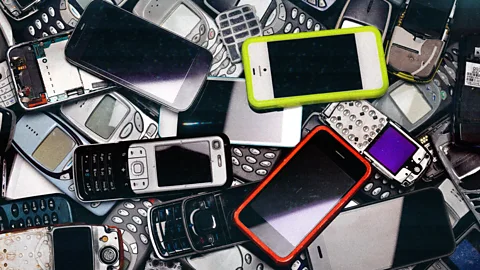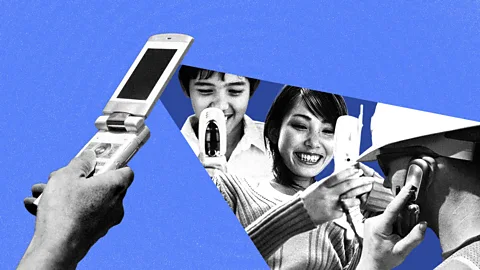Self-labelled neo-Luddites and the tech-stressed are searching for phones with fewer features. Industry experts cite precarious profit margins and a wobbly market around this niche need.
The iPhone turns 17 this year. The launch of the touchscreen-controlled device signalled a moment that has defined our expectations of smartphones ever since. Almost an entire generation has grown up never knowing life without a smartphone. Enough time has passed that people have learnt about the good and bad of these devices in their lives, whether from myriad scientific studies, or simply their own experiences.
Many people are now acutely aware of the costs of having the world at their fingertips. And they’re rejecting the ways these phones can sap concentration, impact sleep and exacerbate mental health concerns.
There are plenty of relatively simple ways to address these issues to some extent – say, installing apps that limit screen time – but some people are deciding to go further, returning to a time before constant connection. They’re transitioning to “dumbphones”, a catch-all term for phones with basic functions such as calling, texting and setting alarms. Some dumbphones resemble 90s flip phones. Others are niche, high-end products that provide a downgraded smartphone experience at a surprising premium.
In some cases, concerned parents are turning to these devices as a way of keeping their children away from the distractions of a smartphone. But the market also comprises seniors who want something simple; workers in tough industries like construction or farming, who need rugged handsets; and everyday users who can’t afford to pay the average price of a smartphone, often upwards of $500 (£400), and flagship smartphones can cost as much as $1,600 (£1,300). Abandoning these devices has also become its own trend: teenagers desperate to escape social media have set themselves up as neo-Luddites.
I knew I had to try it, too. Growing up in a home without gaming consoles in the early 2000s, I binged Halo and Borderlands at friends’ places, to the point where I felt dizzy and disoriented. Later, as a newspaper reporter, I drank in Twitter’s firehose of information between deadlines, then spent hours doomscrolling when I got home. During the pandemic, I gave up Twitter, but then succumbed to Instagram Reels. The always-on feeling eroded my sense of wellbeing. Getting off the smartphone wagon seemed perfect for me.
Yet doing so in practice was a bit harder than I expected. First, I had a hard time getting a dumbphone in my hand at all. There were few options and even fewer recommendations, a stark contrast to the millions of smartphone reviews across the internet. I finally found a website from writer and dumbphone advocate Jose Briones, who offers a “dumbphone finder”. I eventually chose a CAT-S22 flip phone, a semi-smart dumbphone, which has access to apps including Google Maps. It cost $69 (£55) and ends any call with a satisfying snap.
The more I learnt about dumbphones, the more I realised the lack of reviews wasn’t necessarily why I was having an issue tracking down a device. Despite demand from a rising trend, I came to understand phone manufacturers have little to no interest in offering these devices. With smartphones comprising the vast majority of all new phone sales, technology giants have little economic incentive to keep churning out new dumbphones or updating their existing line-ups.

Poor economics
While small, there is a market for dumbphones. In the US, August 2023 data from Counterpoint Research shows feature phones – a type of basic dumbphone with stripped down capabilities – comprise just 2% of the handset market. That only accounts for a tiny sliver – but it’s still plenty of devices. Counterpoint estimated feature phone sales in the US alone would hit 2.8 million by the end of the year.
“Feature phones remain consistent in the US as their simple design, affordability and ruggedness still pander to specific demographics,” according to the firm. “Although there will not be a significant spike for feature phones in the market, there are consistent needs that create the steady demand for feature phones in a smartphone-dominated market.”
Jim Roberts, a professor of marketing at Baylor University’s Hankamer School of Business in Texas, says a surprising proportion of the world’s dumbphones are sold in the US – he estimates around 20%, but market data figures vary considerably. “[Consumers] are just finding that they’re not any happier, or are less happy, than they’d like to be,” says Roberts. “And they spend so much time on their phones that they’re seeing that as the culprit.”
According to Statista Market Insights, the total global feature phone market is projected to bring in $10.6bn (£8.5bn) in revenue this year. Yet while phone manufacturers do pull in notable sums from feature phone sales, they have struggled to turn a profit on the stripped-down hardware. And it’s largely not economically worth it to try to improve the business, especially since phones are often only a small division of their overall companies.
The big tech giants don’t want anything that has to do with reducing your smartphone usage because they are not making money on the hardware of the device – Jose Briones
Many of these tech giants generally generate revenue on either software or highly specialised hardware for which consumers will pay hefty price tags. They also have very diverse revenue streams. Samsung, for instance, earns billions each year from its semiconductor division. Simply, these companies have little incentive to cater to dumbphone users, whose revenue potential is relatively miniscule – that is, if they can even make the economics of manufacturing the devices work at all.
Plus, experts say the sheer amount tech giants can charge for smartphones suggests they won’t prioritise feature phone users anytime soon. Briones, who quit smartphones in 2019, explains that bigger tech companies don’t want dumbphones to overtake their flashier, more expensive models. “The big tech giants don’t want anything that has to do with reducing your smartphone usage because they are not making money on the hardware of the device,” he says.

A viable alternative?
For companies that do still offer dumbphones, Thomas Husson, vice president and principal analyst at Forrester Research, doesn’t expect many of these sellers to make it – or at least keep manufacturing these devices in the long run.
Alongside precarious profit margins, there’s also the wrinkle that the technology on which these devices run will become so outdated they won’t be able to function. For instance, dumbphone users across the globe will be out of luck if the 2G and 3G networks that sustain their functionality disappear entirely. Plus, many jobs – even low-wage positions – require employees to carry phones with app capabilities. At the end of the day, there may not be enough customers to buoy even the savviest business model.
There may be one way dumbphone companies can survive, however. To be economically viable, argues Husson, companies could “develop a niche premium brand to reach these segments”. Indeed, some start-ups are trying to capture this specialty market and find economic success – offering a kind of modern take on the feature phone.
New York-based Light creates customisable “Light Phones” that minimise exposure to the internet, social media and other distractions. “What we’re trying to do with the Light Phone isn’t to create a dumb phone, but to create a more intentional phone – a premium, minimal phone – which isn’t inherently anti-technology,” Joe Hollier, co-founder of Light, told CNBC in 2023. The device currently costs $299 (£240) – comparable with low- or mid-range smartphone models. It’s a high price point for a dumbed-down phone, but the only way for the company to make a niche product economically viable.
Unlike feature phones, which usually sell based on their low price point or ruggedness, Light’s phones are intended for conscientious digital detoxers who want some connectivity without sacrificing on style or some functionality. Briones’s Light Phone calls, texts and has basic app functions, all viewable through an e-ink screen similar to an e-reader. It can also keep a calendar, get directions, stream podcasts and music and take notes. “That’s a good set of features that I’ve been able to learn how to live with,” he says.
More like this:
- The ‘unhinged’ product mash-ups that sell out in hours
- The trendy second-hand clothing market is tanking
- Will gamers play along with a subscription model?
Earlier this year, Swiss brand Punkt also debuted a simplified smartphone for $750, priced at £599 in the UK. They’re betting high-end consumers will be interested in hardware that resembles the smartphones they are used to. Punkt has pivoted towards the luxury dumbphone approach; in 2015, the company offered a feature phone that looked similar to an iPhone, but that only made calls, sent text messages and had a calendar and clock. It did not take off.
These new devices will also have to compete with other business models meant to appeal to users who want to wean their digital dependence, but may want to do so in a way that goes down smoother than a hardware transition.
That’s the strategy for US-based Ghost Mode. Rather than selling its own phone, the company essentially reprograms a Google Pixel 6a smartphone to a customer’s specifications, with all of the apps they need. Once they do, Ghost Mode locks the phone into those settings. Like most of these niche products, this service isn’t cheap at $600 (£482), but it may appeal to top-end consumers more than leaving their smartphones behind entirely.
Despite these new players and a heightened interest in dumber phones, success is still precarious.
Bullitt, the licensed manufacturers of the CAT S-22 I purchased, folded the day before my phone arrived. Despite the news, I tried the hardware for about a week. It let me call, text and access the messenger functions of a couple of apps I used to stay in touch with friends and family. My total web use dropped to just an hour a day. I was better able to concentrate on my surroundings, books and music. But I missed my library app.
So, I switched back to my very beaten-up Samsung Galaxy A32 – with a catch. I installed Minimalist Phone, an app that gets rid of flashy app icons and backgrounds in favour of a stark black-and-white interface. I kept Messenger, WhatsApp and Discord to stay in touch, but nearly every other non-basic app went out the window. I don’t miss them.









